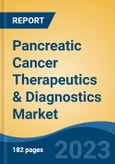Speak directly to the analyst to clarify any post sales queries you may have.
10% Free customizationThis report comes with 10% free customization, enabling you to add data that meets your specific business needs.
Pancreatic cancer is a relatively rare cancer, accounting for a small percentage of all cancer cases. However, it is one of the most lethal forms of cancer, with a low survival rate. The incidence of pancreatic cancer varies by region, with some areas experiencing higher rates than others. Risk factors include age, family history, smoking, obesity, and certain genetic mutations.
Key Market Drivers
Rising Incidence of Pancreatic Cancer
The increasing incidence of pancreatic cancer is a major driving force behind the expansion of the Global Pancreatic Cancer Therapeutics & Diagnostics Market. Pancreatic cancer remains one of the most lethal malignancies, posing a significant challenge to global healthcare systems. In 2020, approximately 500,000 new cases were reported worldwide, with 470,000 fatalities, underscoring the disease's high mortality rate. The global incidence rate stood at 4.9 cases per 100,000 people, while the mortality rate reached 4.5 per 100,000, highlighting the urgent need for more effective diagnostic and therapeutic interventions.This trend is influencing the demand for advanced treatment options, early diagnostic solutions, and improved healthcare infrastructure. Pancreatic cancer is among the most aggressive malignancies, with a high mortality rate. Due to late-stage diagnoses and limited treatment options, the survival rate remains low. The five-year survival rate for pancreatic cancer varies significantly based on the stage at diagnosis. For patients diagnosed at an early, operable stage, the survival rate reaches 20%. However, when considering all cases - including advanced, inoperable stages - the overall five-year survival rate drops to just 5%. The rising number of diagnosed cases worldwide is directly fueling the demand for innovative therapeutic solutions, including chemotherapy, immunotherapy, targeted therapy, and personalized medicine.
Key Market Challenges
High Treatment Costs
Pancreatic cancer treatment can be prohibitively expensive. The disease often necessitates aggressive interventions, including surgery, chemotherapy, radiation therapy, and personalized targeted therapies. These treatments not only involve substantial direct medical costs but also indirect costs related to hospitalization, supportive care, and managing side effects. Additionally, the complexity of pancreatic cancer cases often requires specialized healthcare providers and facilities, further driving up costs.High treatment costs pose financial burdens on patients, healthcare systems, and insurers. This can limit patient access to advanced therapies and diagnostics, impacting market growth. Moreover, it can lead to delays in seeking treatment and influence treatment choices based on cost considerations rather than optimal clinical outcomes.
Key Market Trends
Advancements in Personalized Medicine
Personalized medicine is a significant trend in the treatment of pancreatic cancer. This approach tailors treatment plans based on an individual patient's genetic makeup, tumor characteristics, and other factors. Advancements in genomics and molecular profiling technologies have made it possible to identify specific mutations and biomarkers associated with pancreatic cancer. This trend is driven by the need for more effective and targeted therapies, as standard treatments have shown limited success in improving survival rates for pancreatic cancer patients.The adoption of personalized medicine is expanding the range of therapeutic options available in the market. Pharmaceutical companies are developing targeted therapies that address specific genetic mutations, offering new hope for patients. Diagnostic tools that enable genetic profiling and guide treatment decisions are also in high demand. This trend is expected to drive market growth as more personalized treatment approaches become available.
Key Market Players
- Myriad Genetics Inc.
- Pfizer Inc.
- Novartis AG
- Bristol-Myers Squibb Company
- AstraZeneca PLC
- Amgen Inc.
- Viatris Inc.
- Boston Scientific Corporation
- FUJIFILM Holdings Corporation
- Canon Inc. (canon Medical Systems Corporation)
- Rafael Holdings Inc
Report Scope:
In this report, the Global Pancreatic Cancer Therapeutics & Diagnostics Market has been segmented into the following categories, in addition to the industry trends which have also been detailed below:Pancreatic Cancer Therapeutics & Diagnostics Market, By Type:
- Treatment
- Diagnostics
Pancreatic Cancer Therapeutics & Diagnostics Market, By End User:
- Hospitals & Clinics
- Ambulatory Centers
- Others
Pancreatic Cancer Therapeutics & Diagnostics Market, By Region:
- North America
- United States
- Canada
- Mexico
- Europe
- France
- United Kingdom
- Italy
- Germany
- Spain
- Asia-Pacific
- China
- India
- Japan
- Australia
- South Korea
- South America
- Brazil
- Argentina
- Colombia
- Middle East & Africa
- South Africa
- Saudi Arabia
- UAE
Competitive Landscape
Company Profiles: Detailed analysis of the major companies present in the Global Pancreatic Cancer Therapeutics & Diagnostics Market.Available Customizations:
With the given market data, the publisher offers customizations according to a company's specific needs. The following customization options are available for the report.Company Information
- Detailed analysis and profiling of additional market players (up to five).
This product will be delivered within 1-3 business days.
Table of Contents
Companies Mentioned
- Myriad Genetics Inc.
- Pfizer Inc.
- Novartis AG
- Bristol-Myers Squibb Company
- AstraZeneca PLC
- Amgen Inc.
- Viatris Inc.
- Boston Scientific Corporation
- FUJIFILM Holdings Corporation
- Canon Inc. (canon Medical Systems Corporation)
- Rafael Holdings Inc
Table Information
| Report Attribute | Details |
|---|---|
| No. of Pages | 180 |
| Published | March 2025 |
| Forecast Period | 2024 - 2030 |
| Estimated Market Value ( USD | $ 4.6 Billion |
| Forecasted Market Value ( USD | $ 7.12 Billion |
| Compound Annual Growth Rate | 7.5% |
| Regions Covered | Global |
| No. of Companies Mentioned | 11 |









